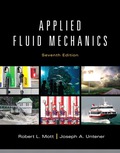
Applied Fluid Mechanics
7th Edition
ISBN: 9780133414622
Author: UNTENER
Publisher: YUZU
expand_more
expand_more
format_list_bulleted
Textbook Question
Chapter 19, Problem 19.30PP
Forthe conditions shown in figs. 19.719- 19.10 0, complete the design of the duct system by specifying the sizes for all duct sections necessary to achieve a system that is balanced when it carries the flow rates shown. Compute the pressure at the fan outlet, assuming that the final outlets from the duct system are to atmospheric pressure. When an inlet duct section is shown, also complete its design and compute the pressure at the fan inlet. Note that there is no single best solution to these problems, and several design decisions must be made. It may be desirable to change certain features of the suggested system design to improve its operation or to make it simpler to achieve a balanced system.
Expert Solution & Answer
Want to see the full answer?
Check out a sample textbook solution
Students have asked these similar questions
No chatgpt pls will upvote
reading is 0.4 mas SHOWN.
Assume h₁ = 0.4 m, h₂ = 0.5 m.
(a) Do you know the specific weight of mercury?
(b) Do you know the specific weight of gasoline?
(c) Do you know the specific weight of oil?
(a) YHg
=
133,000
(b) Ygas
= 6867
(c) Yoil =
8829
eTextbook and Media
Part 2
N/m³
N/m³
N/m³
A+
Gasoline
t
+B
Oil
-Mercury
Attempts: unlimited
Did you calculate the pressure difference between two locations using the correct specific weight?
Did you assume that the pressures in fluid are the same in a horizontal plane even though they are in different tubes?
Are the calculated pressures in a column of fluid always higher at lower elevations?
Did you account for the fact that the two horizontal tubes of the U-tube are above the ground?
Concepts: The pressure in a fluid is a function of the specific weight of the fluid and the height relative to a reference.
Pressure is constant in a horizontal plane of a continuous mass of fluid.
(a) What is the initial pressure difference? (PA-PB)
(b) What is…
Find the solution of the following Differential Equations
1)
"-4y+3y=0
3) "+16y=0
2) y"-16y=0
4) y"-y-6y=0
5) y"+2y=0
7) y"+y=0, (#0)
9) y"-y=0, y(0) = 6, y'(0) = -4
11) y"-4y+3y=0, y(0)=-1,
13)
y'(0) = -5
"+2y+2y=0
15) y"-9y=0
17) y"-4y=0
6) y"-2y+2y=0
8)
"+4y+5y=0
10) y"-9y=0, y(0) = 2, y'(0) = 0
12) y"-3y+2y= 0, y(0)=-1,
y'(0) = 0
14) 4y+4y+y=0
16) "+6y+12y=0
18) 4y+4y+17y=0
Chapter 19 Solutions
Applied Fluid Mechanics
Ch. 19 - Determine the velocity of flow and the friction...Ch. 19 - Repeat Problem 19.1 O for duct diameters of 16,...Ch. 19 - Prob. 19.3PPCh. 19 - Determine the velocity of flow and the friction...Ch. 19 - Repeat Problem 19.40 for duct diameters of...Ch. 19 - Prob. 19.6PPCh. 19 - Prob. 19.7PPCh. 19 - '19.8 A branch duct for a heating system measures...Ch. 19 - Prob. 19.9PPCh. 19 - Prob. 19.10PP
Ch. 19 - A branch duct for a heating system measures 75250...Ch. 19 - Prob. 19.12PPCh. 19 - Prob. 19.13PPCh. 19 - Prob. 19.14PPCh. 19 - Repeat Problem 19.14, but use a five-piece elbowCh. 19 - Prob. 19.16PPCh. 19 - Prob. 19.17PPCh. 19 - Prob. 19.18PPCh. 19 - Prob. 19.19PPCh. 19 - Prob. 19.20PPCh. 19 - Compute the pressure drop as 0.20m3/s of air flows...Ch. 19 - Prob. 19.22PPCh. 19 - Compute the pressure drop as 0.85m3/s of air flows...Ch. 19 - A section of duct system consists of 42 ft of...Ch. 19 - A section of duct system consists of 38 ft of...Ch. 19 - The intake duct to a fan consists of intake...Ch. 19 - Forthe conditions shown in figs. 19.719- 19.10 0,...Ch. 19 - Forthe conditions shown in figs. 19.719- 19.10 0,...Ch. 19 - Prob. 19.29PPCh. 19 - Forthe conditions shown in figs. 19.719- 19.10 0,...
Knowledge Booster
Learn more about
Need a deep-dive on the concept behind this application? Look no further. Learn more about this topic, mechanical-engineering and related others by exploring similar questions and additional content below.Similar questions
- Access Pearson Mastering Engineering Back to my courses Course Home Course Home Scoresarrow_forwardAccess Pearson Mastering Engineering Back to my courses Course Home Course Home Scores Review Next >arrow_forwardAccess Pearson Course Home Scoresarrow_forwardCan you answer this question?arrow_forwardCan you answer this question?arrow_forwardA gear has a gear wheel with 16 teeth. The gear should be dimensioned for the highest and lowest gear ratio. Looking for output power, torque, speed?nin= 2000 rpmmin = 30Nmn=0,9a max= 450 mmModule 4Gear limitsz1 z213 13-1614 14-2615 15-4516 16-10117 17-131418 18-…..I have calculate but I can’t get the right answers…..√16 =459x60/56x57=1.1 lowest59x60/13x13=20,94 highestnut=2000/1.1= 1818rpmnut=2000/20.94=95.5 rpmMut=1.1x30=33 NmMut=20.94x30=628,2 Nm(Right answer)LowestZ=13, M=24,4Nm, n=2462 rpmHighestZ=92, M=172,5Nm, n=347,8 rpmP=5655W on botharrow_forwardarrow_back_iosSEE MORE QUESTIONSarrow_forward_ios
Recommended textbooks for you
 Refrigeration and Air Conditioning Technology (Mi...Mechanical EngineeringISBN:9781305578296Author:John Tomczyk, Eugene Silberstein, Bill Whitman, Bill JohnsonPublisher:Cengage Learning
Refrigeration and Air Conditioning Technology (Mi...Mechanical EngineeringISBN:9781305578296Author:John Tomczyk, Eugene Silberstein, Bill Whitman, Bill JohnsonPublisher:Cengage Learning

Refrigeration and Air Conditioning Technology (Mi...
Mechanical Engineering
ISBN:9781305578296
Author:John Tomczyk, Eugene Silberstein, Bill Whitman, Bill Johnson
Publisher:Cengage Learning
Intro to Compressible Flows — Lesson 1; Author: Ansys Learning;https://www.youtube.com/watch?v=OgR6j8TzA5Y;License: Standard Youtube License